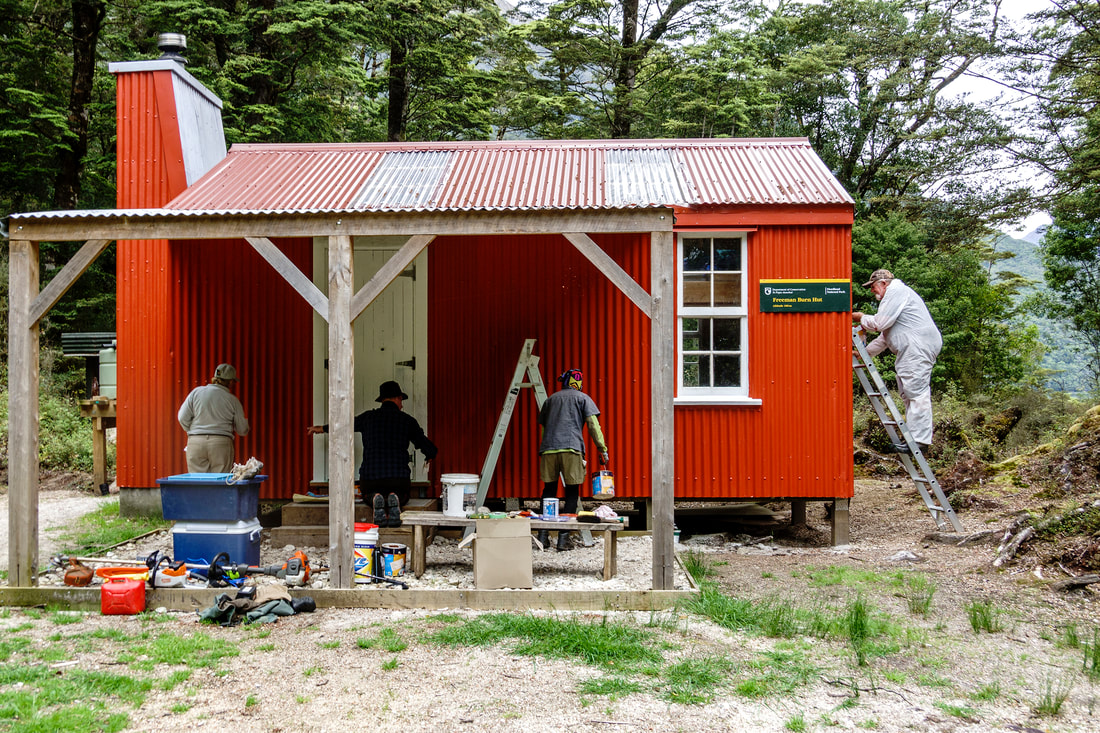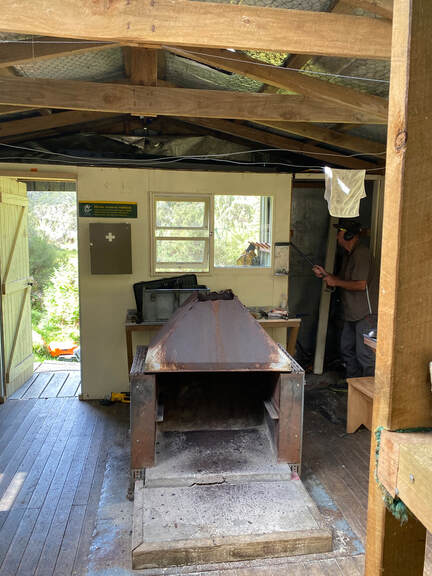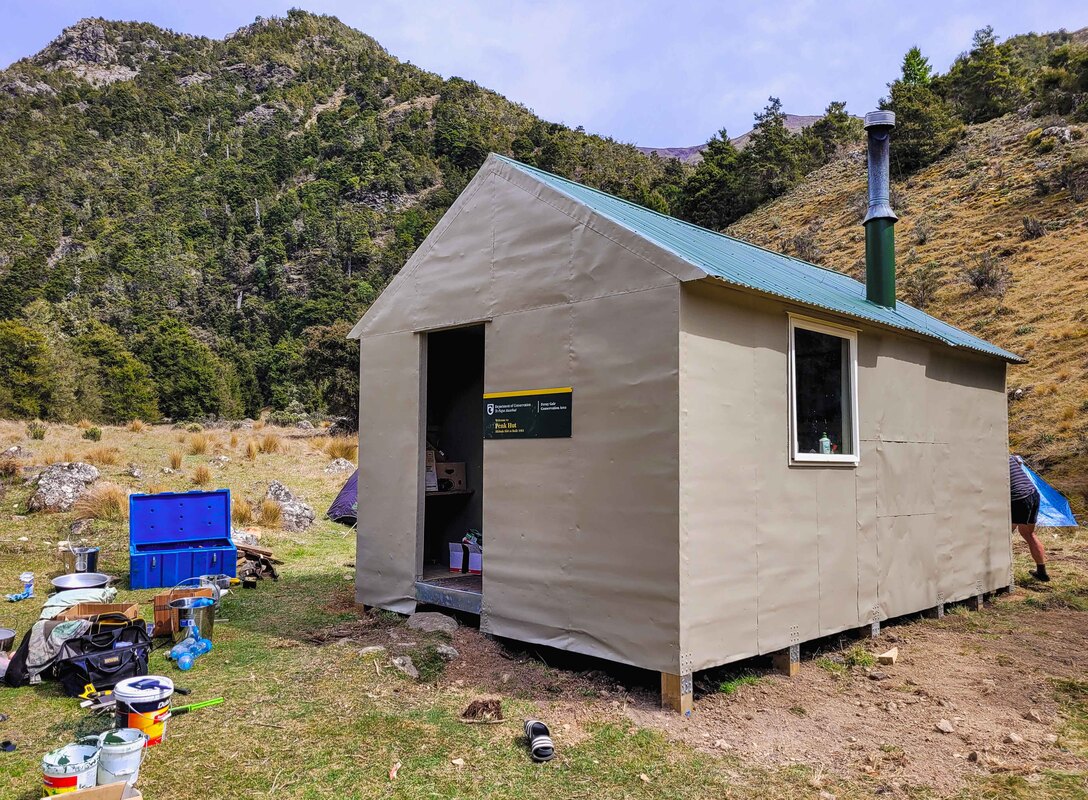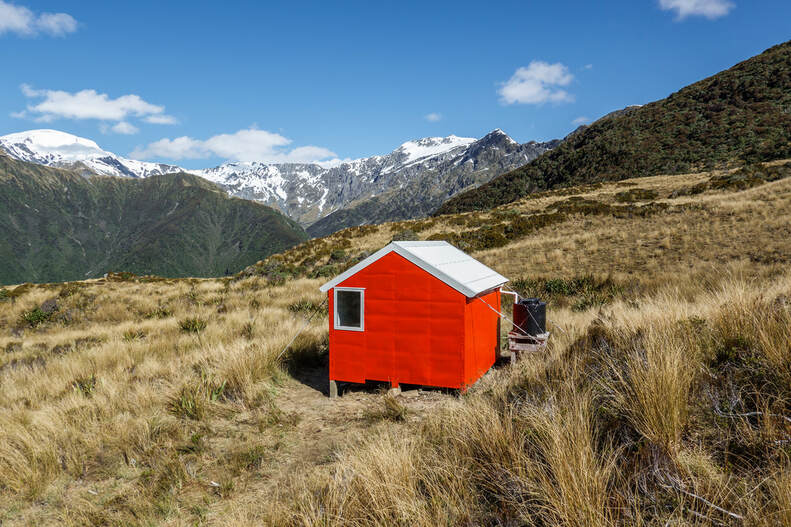|
Lake Manapouri, Fiordland National Park, Southland – February 2022 Located at the mouth of the Freeman Burn, on the shores of beautiful Lake Manapōuri, Freeman Burn Hut has long served as a haven for boaties, kayakers, trampers, hunters and tourists. The historic hut was first built over the summer of 1928–29 by tourism pioneer Les Murrell, who had an ambitious plan to establish a tourist trail to Bradshaw Sound. Today, the hut stands as solitary monument to Murrell’s efforts. The passage of nearly a century had however taken its toll. Vandals had also done significant damage, many of the piles needed replacing, and the windows were rotten. Additionally, the original hut structure had many deficiencies, including inadequate framing, and even most of what did exist was badly out of plumb.
Clearly the hut needed work, but how much of the old structure could be retained, and how much needed replacing? These were questions that tested consultant Simon Brackstone and Backcountry Trust manager Rob Brown during a recent rebuild/restoration of the hut. Keen members of the Southern Lakes branch of the New Zealand Deerstalkers’ Association carried out the work. Here’s the story, and more about the hut’s unusual origins. First, a tale of two Les’s. Tararua Forest Park, Wellington – February 2022 Penn Creek Hut occupies a grassy clearing on the banks of its namesake creek, a tributary of the mighty Ōtaki River. From Ōtaki Forks, a good track leads to Penn Creek via Field Hut and Table Top, making it accessible in a long day, or an easier overnight tramp.
The six-bunker is one of a dozen or so ex-Forest Service deer-culling huts remaining in the Tararua Range, and recently got some attention from the ex-NZFS group, organised by the ever-energetic John McCann and his team of merry men. They were supported by a grant from the Backcountry Trust.  Historic elements of the bridge were retained where possible. Historic elements of the bridge were retained where possible. We don't often get involved in projects quite so close to the road end but when the Temple Basin Ski Club Charitable Trust approached us back in 2021 to contribute to the restoration of the historic road bridge joining the two carparks the BCT board decided there were wider backcountry access issues worthy of support. The bridge has been identified in the Arthur's Pass National Park Management Plan as one of the last surviving original road bridges over the Southern Alps, but time had taken its toll and eventually it had failed an engineering inspection to carry vehicle traffic. Originally built sometime during the Cobb & Co era between 1866 and 1910, the bridge had a good amount of rotten timber that needed replacing and steel strengthening to be able to take vehicles up to 3,500kg. NZTA had previously contributed to its maintenance but it no longer met funding criteria so the Temple Basin Ski Club set about fundraising the $75,000 needed for the work. The Backcountry Trust contributed $20,000 to the final total and the work was completed in April 2022. DOC Rangiora Ops Manager Kingsley Timpson worked closely with all parties to help bring this project together and tick off another job in the Arthur's Pass National Park Management Plan. The final build and project management was organised by the volunteers in the Temple Basin Charitable Trust. The Temple Basin Ski Club has for many years been managing the power, water and sewage removal from this public facilities in Temple Basin, as well as at their own lodge and facilities, and this work helps to cement the ongoing partnership with community organisations who help maintain this part of the park. The Canterbury Mountaineering Club took on the responsibility for Lockwood Shelter sometime ago and are currently looking at options to deal with the back log of deferred maintenance on this facility. Dusky Track, Fiordland National Park, Southland – 12-15 December 2022 & 17-20 February 2023 Halfway Hut is the third hut on the Dusky Track that the Backcountry Trust's has targeted for catch-up maintenance. It is the last of the original Dusky Track huts that still had an open fire and this had recently failed an inspection and needed to be replaced. The 12-bunk hut takes it name from being halfway up the Hauroko Burn, which provides access onto the tops of the aptly-named Pleasant Range The roof was also past its best and was in need of the lead being removed as we are doing now for all huts in the mountain areas where there are kea present. In December 2022, builders Clint Jarvis and Mark Williamson went in with the roofing maestro Vítek Kočandrle and Paul Chinn. Over four days they re-roofed the hut, removed the old fireplace and installed a new Wagner Cooktop wood burner. The weather was perfect the whole week and the team was able to get in and out from the Borland Saddle loading area as efficiently as possible. The work completed by this team followed on from the renovation of Lake Roe Hut in 2021 and Spey Hut in 2020 by the Southern Lakes Branch of the NZDA. Stage two to complete the Halfway Hut work was carried out by a Permolat Southland colunteer crew in February 2023. The team included Hayden Cohen, Garth Lornie, John McDonald, Karen Nicholson and Greg Wilson.
Waitōtara Conservation Area, Whanganui – January 2023 A team of volunteers supported by the Backcountry Trust recently spent time working on the Waitōtara Track, which links the Waitōtara River with the Matemateāonga Track in the Whanganui-Taranaki backcountry. The aim was to clear all the many windfalls on the entire track with chainsaw crews, thus completing hand-clearing work undertaken the summer before.
Ferny Gair Conservation Area, Marlborough – December 2022 Black Birch Biv occupies an elevated knoll between the Blairich and Black Birch Ranges in southern Marlborough. It’s reached on a track from near Black Birch Station, in the Awatere Valley, west of Seddon. In 2015, the bivvy was relcoated here from another site, in a joint project between the Marlborough Branch of the New Zealand Deerstalkers’ Association, DOC, and the Backcountry Trust. As well as moving the bivvy, the team also adding an extension (visible in above picture).
In December 2022, NZDA member Simon Wayatt led a small team in to do some more work on the bivvy, as part of a wider project doing up huts in the Ferny Gair Conservation Area (see Penk Hut and Lake Alexander Hut blogs). Kāweka Forest Park, Hawke’s Bay – October 2022 Over a three-day weekend in spring, a hardy crew of 17 volunteers, one DOC ranger and the Backcountry Trust’s very own Megan Dimozantos set to work on a range of tracks in the eastern Kāweka Forest Park. Split into six teams, they cleared tracks by hand, and also used scrub-bars and chainsaws. In addition, the teams marked and re-poled sections of the alpine routes.
Ferny Gair Conservation Area, Marlborough – December 2022 Lake Alexander is a rare example of a lake in the Marlborough backcountry. The attractive bush-surrounded lake lies near the headwaters of the Tummil River, in the Waihopai Valley, southwest of Renwick. Near the lake is Lake Alexander Hut, a standard six-bunk Forest Service design. Built in 1965, and originally called Tummil Hut, it was relocated to its present site in 2010.
Simon Wayatt from the Marlborough Branch of the New Zealand Deerstalkers’ Association (NZDA) has been undertaking some excellent work in the area, with support from DOC ranger Ray Bennett. In December 2022, Simon flew into Lake Alexander Hut with fellow NZDA member Paula Carter. Their main mission was to install a new water-tank. Previously, hut occupants had to walk for some 10 minutes to get water. Fiordland National Park, Southland – January 2023 Sprawling alpine lakes, granite tops and the stupendous Mt Irene: the location of Robin Saddle Hut certainly takes a lot of beating. Situated in the heart of Fiordland, at the very western extent of the Murchison Mountains, this is one of the remotest huts in the country, and also one of the hardest to reach. Now over 60 years old, the hut got a comprehensive upgrade by a New Zealand Alpine Club (NZAC) volunteer team led by Paul Maxim.
Ferny Gair Conservation Area, Marlborough – October 2022 Penk Hut lies in the headwaters of Marlborough’s Penk River, a significant tributary of the Awatere River. The standard 6-bunk ex-NZFS hut lies near the forks of two creeks that drain the high slopes of Ferny Gair (1670 metres). In October 2022, the hut got some overdue attention from Backcountry Trust volunteers led by hunter Simon Wyatt, with help from DOC ranger Ray Bennett. The rest of the volunteers, also keen hunters, included John Flannagan, Jock Flannagan, Matt Large and Paul Fuller.
Tararua Forest Park, Wairarapa – 6-10 September 2022 \Some guess Field, others think Cone, but no, the oldest hut in Tararua Forest Park is actually Sayer Hut.
Built in the early 1900s by the Sayer family, who used to run cattle on Tōtara Flats, this rustic hut has stood in place for more than century, albeit with many modifications over the decades. It was there when the Tararua Tramping Club formed; it was there when members of a missing tramping party wandered past, oblivious to the hut, in the infamous Sutch Search of 1933. In a nice turn of history, members of the Sayer family recently did a marvellous job of re-cladding the hut, helped by a grant from the Backcountry Trust. Kakapotahi River Area, West Coast - October 2022 Dickie Spur Hut occupies a terrace near the bushline above the Tuke River, south of Hokitika. It’s most often reached on a track up the Mikonui River, past Mikonui Flats Hut, up the Tuke to Truran Pass. From there, a staunch climb leads up Dickie Spur itself. The four-bunk, ex-Forest Service hut recently received some welcome attention from a combined team of Backcountry Trust volunteers and builders. They did a great job, and Dickie Spur Hut is looking tip-top.
Whataroa Valley, West Coast – April 2022 Stan’s Hut sits on an elevated shoulder high above the Whataroa valley. The 4-bunk hut is blessed with exceptional views, low sandfly numbers, surrounding native scrub with healthy birdlife, as well as handy access to the tops. At Easter, a three-strong team of volunteers funded by the Backcountry Trust flew in complete a fine refurbishment of Stan’s. Led by Dave Keen, the group included Dave’s son Josh, and Michael Wilson.
Hunting guide Stan Peterson built the hut in 1985, on a site where he had previously maintained a tent camp. When Stan retired from guiding in the early 2000s, he donated the hut to the New Zealand chapter of Safari Club International (SCI). A few years later, the hut got a new roof and porch area, but time marched on and once again it needed some attention. Tararua Forest Park, Wairarapa – March 2022 Herepai is one of the most northerly huts in the Tararua Range, set in a small bush clearing above Ruapae Stream, and a launching pad for trips across the rugged tops beyond. It was built in 1980 by NZ Forest Service rangers Hans Kolinko and Mark Hunter, with assistance from members of the Pahiatua-based Bush Tramping Club. Unfortunately, Herepai Hut has received little attention in recent years and was in very poor condition.
Happily, in March a huge effort by Backcountry Trust volunteers – led by the irrepressible builder Steve Wilman – completely transformed the ailing hut. As well as doing behind-the-scenes organising, the BCT’s Megan Dimozantos was there on the tools as well. The rest of team included Fiona Burleigh, Tina Christie, Matt Falepau and Roy Rolston. Kaweka Forest Park, Hawke’s Bay – 27-29 May 2022 Black Birch Bivvy occupies a pleasant clearing in the forest of the Black Birch Range in the eastern Kaweka Forest Park. The two-bunk dogbox-style bivouac was originally built by the Forest Service in the 1960s, and has provided an accessible place for hunting and tramping ever since. In May, a Sika Foundation team made some significant improvements to the bivvy to increase its capacity and make it more user-friendly.
The volunteers included Alex Dixon, Ben Gordon, Mike Main, Brett Stokman (lead builder) and Joseph Turner. West Coast – 15-18 April 2022 Recent work at Top Waitaha and Mullins Huts by Backcountry Trust volunteers has breathed new life into these backcountry locations. However, both huts needed toilet facilities.
After Jane Morris secured funding, it was decided to co-ordinate the two projects. Colin Morris constructed the toilets, using a simplified design adapted from plans provided by DOC’s Tony Thrupp. In April, a BCT team of three flew in to install them. Personnel were: Colin Morris (qualified carpenter), Roger Woods (former project manager for Fletcher) and Col Pearson (professional painter), all from Canterbury. Kahurangi National Park, Nelson – May 2022 Nestled under the flanks of Mt Arthur in Kahurangi National Park is Ellis Hut, an important base for cavers, and a welcome haven for trampers too. Last year this great 6-bunk hut got some much needed attention from a Backcountry Trust (BCT) volunteer team of climbers and cavers, which including putting in a new cooking bench and removing of soil and rock under the hut to aid ventilation (see blog April 2021).
As is often the case, this working bee hatched even bigger plans. The two main goals were to replace the existing open fire with a decent wood-burner, and add a foyer to the hut for use by cavers to hang wet gear. The Ellis Basin is karst country, with several small sink holes visible around the hut, and cavers often return wet and dirty from their explorations. The BCT once again funded the cost of materials and transport. Tararua Forest Park, Wairarapa – March 2022 Carkeek Hut lies in the heart of the Tararua Ranges, and can be regarded as the most remote hut in the forest park. The six-bunk occupies a ridge-top position on the 6-bunk Carkeek Ridge, high above the headwaters of the rugged Waiohine River. It recently got a makeover by members of the ex-NZFS team, using funding from the Backcountry Trust.
Tararua Forest Park, Wairarapa – January 2022 High on a spur above the Waiohine valley lies McGregor Bivouac, a classic Forest Service era two-bunk dog-box bivvy. Nestled against the edge of the forest, the bivvy has commanding views north over the upper Waiohine catchment and the peaks of the northern Tararua Range. It’s most often reached from the Holdsworth Road end via the Atiwkahatu and Jumbo tracks. From Jumbo, a route over the tops, past Angle Knob, leads to a signposted turnoff that descends to the bivouac. Built in 1966, the bivouac has been maintained over the years, but recently reports of it leaking reached John McCann, the man behind the ex-NZFS team. McCann organised for two members of the volunteer group, Grant Timlin and Roy Winterburn, both ex-cullers, to walk in and inspect the bivouac. They found that when the bivouac got new piles some years ago, this had exposed the bottom bearers. They also discovered that many of the old clouts in the cladding had completely rusted through. McCann talked through options with Megan Dimozantos, the Backcountry Trust’s North Island manager. One option was a completely re-roof and cladding, and the other was replacing the clouts with screws and rubber washers. McCann, however, felt a complete re-clad was unnecessary, and that the screws would give the bivouac a ‘pimply’ appearance, undermining its authenticity. One the guiding principles of the exNZFS is to retain originality when possible. Accordingly, Grant Timlin and Roy Winterburn flew in by helicopter in February 2022, and replaced all the clouts with new ones. They also added a skirting to protect the bearers from the weather, and replaced the window. An unoriginal ceiling seemed to be retaining moisture inside the hut, so this was removed. McCann hopes these solutions will keep the bivvy watertight. The ex-NZFS team now maintains some 16 huts in the Tararua and Aorangi Ranges, and aims to ensure huts from the NZFS deer-culling era have a long life ahead. Next in their sights is some work on the Mid King Bivouac.
West Coast – 25-27 March 2022 Bald Hill and Fraser Peak are twin summits on the West Coast’s Bald Hill Range, about 35 kilometres south of Hokitika. While only modest in height – about 1160 metres, these two peaks protrude above the bushline, offering good views of the Mikonui, Tōtara and Whitcombe valleys on either side. In March 2022, a team of Permolat volunteers worked on the route between the peaks, with funding from the Backcountry Trust. The crew included Ted Brennan, Andrew Buglass, Annie Hughes, Jane Morris, Joke de Rike and Geoff Spearpoint.
Lake Sumner Forest Park, Canterbury – March 2022 In the southeastern quadrant of Lake Sumner Forest Park is the Jollie Brook catchment, which drains the mountains of the Glynn Wye Range. From the Lake Sumner Road, a track leads up the valley, connecting two huts. While Cold Stream Hut, located up a tributary of the same name, is a standard ex-Forest Service 6-bunk design, the 7-bunk Jollie Brook Hut itself is more unusual. It comprises a central living room, with bunkrooms on either side. The only other hut of this exact design is Three Mile Stream, also in Lake Sumner Forest Park.
In March, volunteers Greg Jarvis, Pete McBeth and Geoff Spiers got stuck in to restore both Cold Stream and Jollie Brook Huts, aided by a Backcountry Trust grant. Lake Monowai, Fiordland National Park, Southland – 11-15 March 2022 Lake Monowai curls like a sickle in the mountains of eastern Fiordland, flanked by the Kaherekoau Mountains on one side, and Cleughearn peak on the other. Beside its shores lie four huts: Monowai Hut, the two Rodger Inlet Huts, and Eel Creek Hut. Like some others in the area, Eel Creek Hut is an A-Frame design, and members of Permolat Southland restored it March, with funding from the Backcountry Trust.
Waitōtara Conservation Area, Whanganui – 8-15 March 2022 The second-largest extent of native forest in the North Island empasses a huge area in the backcountry between Whanganui and Taranaki. The Whanganui National Park protects a significant part of these forests, through which the well-known Matemateāonga Track crosses.
Less well-known and visited are the forests of the Waitōtara Conservation Area, which has a network of tracks that connect with the Matemateāonga Track. These tracks have received little attention in recent years, and become overgrown and difficult to follow. That changed in March, when a group of volunteers, mainly from Auckland, got stuck in to open up a significant section of the tracks north of Tahupo and Puteore Huts. Most of the group had previous experience working on tracks in the Kaimai Range. The six-strong group split in two. At Tahupo Hut were Tony Walton, Geoff Mead and Luitgard Schwendemann, while staying at Puteore Hut were John Parsons, Catherine Doyle and Jane Marjoribanks. Lake Sumner Forest Park, Canterbury – March 2022 Lake Sumner Forest Park straddles the Lewis Pass highway, which provides access to the area’s many pleasant valleys. One of these is the Doubtful Valley, which boasts a track and two huts: one predictably called Doubtful Hut, and the other more whimsically known as Doubtless Hut. The latter hut lies near the headwaters, and recently had a welcome makeover from a volunteer team.
Coromandel Forest Park – Summer 2021-22 The Rangihau is a neglected backcountry track at the head of the Kauaeranga Valley in Coromandel Forest Park. Running north from the popular Pinnacles Hut, the track provides access to several historically significant sites – including the main Kauaeranga Kauri Dam site and work camps. This area was the site of some of the last significant kauri milling in the country, during the mid-1920s, with important relics remaining.
|
Projects
June 2023
|








































